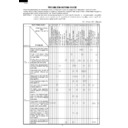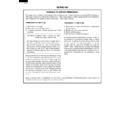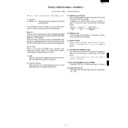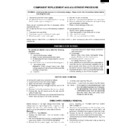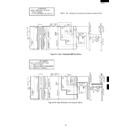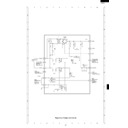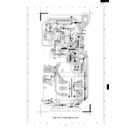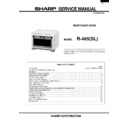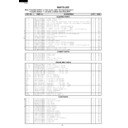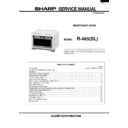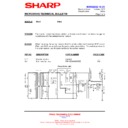Read Sharp R-465 (serv.man3) Service Manual online
R-465(SL)
6
CK = Check / RE = Replace
MAGNETRON
HIGH VOLTAGE TRANSFORMER
H.V. RECTIFIER ASSEMBLY
HIGH VOLTAGE CAPACITOR
1ST. INTERLOCK SWITCH
2ND.INTERLOCK RELAY
CONTROL SWITCH
MONITOR SWITCH
MONITOR RESISTOR
THERMAL CUT-OUT 125
˚C
FAN MOTOR
TURNTABLE MOTOR
FUSE F10A
TOUCH CONTROL PANEL
KEY UNIT
RELAY (RY-1, RY-2)
FOIL PATERN ON P.W.B.
POWER SUPPLY CORD
SHORTED WIRE HARNESS
OPENED WIRE HARNESS
OVEN LAMP
WALL OUTLET
MISADJUSTMENT SWITCH
HOME FUSE OR BREAKER
BLOCKED COOLING FAN
BLOCKED VENTILATION
NOISE FILTER
HIGH VOLTAGE FUSE
Home fuse blows when power
supply cord is plugged into
wall outlet.
supply cord is plugged into
wall outlet.
FUSE F10A blows when
power supply cord is plugged
into wall outlet.
power supply cord is plugged
into wall outlet.
Display does not show any-
thing when power supply cord
is plugged into wall outlet.
thing when power supply cord
is plugged into wall outlet.
Display does not operate prop-
erly when STOP/CLEAR key
is touched.
erly when STOP/CLEAR key
is touched.
Oven lamp does not light at
door opened. (Display ap-
pears.)
door opened. (Display ap-
pears.)
Oven does not start when the
START key is touched. (Dis-
play appears)
START key is touched. (Dis-
play appears)
Oven lamp does not light (Dis-
play appears.)
play appears.)
Fan motor does not operate.
(Display appears.)
(Display appears.)
Turntable motor assembly
does not operate. (Display ap-
pears.)
does not operate. (Display ap-
pears.)
Oven or any electrical parts
does not stop when cooking
time is 0 or STOP/CLEAR key
is touched.
does not stop when cooking
time is 0 or STOP/CLEAR key
is touched.
Oven seems to be operating
but little or no heat is produced
in oven load. (Microwave
power level is set at HIGH)
but little or no heat is produced
in oven load. (Microwave
power level is set at HIGH)
Oven does not seems to be
operating properly when 70%,
50%, 30% or 10% is set. (Oven
operates properly at 100%
power and when the STOP/
CLEAR key is touched the
oven stops.)
operating properly when 70%,
50%, 30% or 10% is set. (Oven
operates properly at 100%
power and when the STOP/
CLEAR key is touched the
oven stops.)
Oven goes into cook cycle but
shuts down before end of cook-
ing cycle.
shuts down before end of cook-
ing cycle.
TEST PROCEDURE
A B C D E
E
E G F H H I L M N O
RE CK CK RE CK CKCK CK CK
J K
CONDITION
PROBLEM
POSSIBLE CAUSE
AND
DEFECTIVE PARTS
ON
CONDITION
CONDITION
OFF
CONDITION
CONDITION
TROUBLESHOOTING GUIDE
When troubleshooting the microwave oven, it is helpful to follow the Sequence of Operation in performing the
checks. Many of the possible causes of trouble will require that a specific test be performed. These tests are given a
procedure letter which will be found in the "Test Procedure"section.
IMPORTANT: If the oven becomes inoperative because of a blown fuse F10A in the 1st. interlock switch - relay RY1
checks. Many of the possible causes of trouble will require that a specific test be performed. These tests are given a
procedure letter which will be found in the "Test Procedure"section.
IMPORTANT: If the oven becomes inoperative because of a blown fuse F10A in the 1st. interlock switch - relay RY1
- monitor switch - monitor resistor circuit, check the 1st. interlock switch, relay RY1, monitor switch and
monitor resistor before replacing the fuse F10A.
monitor resistor before replacing the fuse F10A.
R-465(SL)
7
TEST PROCEDURES
PROCEDURE
LETTER
COMPONENT TEST
A
MAGNETRON TEST
NEVER TOUCH ANY PART IN THE CIRCUIT WITH YOUR HAND OR AN INSULATED TOOL
WHILE THE OVEN IS IN OPERATION.
WHILE THE OVEN IS IN OPERATION.
CARRY OUT 3D CHECK.
Isolate the magnetron from high voltage circuit by removing all leads connected to filament terminal.
To test for an open circuit filament use an ohmmeter to make a continuity test between the magnetron
filament terminals, the meter should show a reading of less than 1 ohm.
filament terminals, the meter should show a reading of less than 1 ohm.
To test for short circuit filament to anode condition, connect ohmmeter between one of the filament
terminals and the case of the magnetron (ground). This test should be indicated an infinite resistance.
If a low or zero resistance reading is obtained then the magnetron should be replaced.
terminals and the case of the magnetron (ground). This test should be indicated an infinite resistance.
If a low or zero resistance reading is obtained then the magnetron should be replaced.
MICROWAVE OUTPUT POWER TEST
The power output of this oven is rated using the method specified by IEC 60705. Full details of how
to curry out this procedure can be found in the Sharp Technical Training notes which is available from
Sharp Parts Centre (part number SERV-LITMW01).
to curry out this procedure can be found in the Sharp Technical Training notes which is available from
Sharp Parts Centre (part number SERV-LITMW01).
The IEC60705 procedure must be carried out using laboratory-type procedures and equip-
ment.
These requirements make the procedure unsuitable for routine performance checks.
ment.
These requirements make the procedure unsuitable for routine performance checks.
NOTE: The following test method gives an indication of the output power only, it cannot be used to
establish the actual/rated output power. If the true output power is required, then the
IEC60705 test method must be used.
IEC60705 test method must be used.
Alternative simplified method:
1. Place 2 litres of cold water (between 12
1. Place 2 litres of cold water (between 12
°
C and 20
°
C) in a suitable container.
2. Stir the water and measure the temperature in
°
C. Note temperature as T1.
3. Place the container in the microwave and heat the water for 1 minute and 33 seconds on full power.
4. When the 2 minutes is completed, remove the container and stir the water. Note the water
4. When the 2 minutes is completed, remove the container and stir the water. Note the water
temperature as T2.
5. Calculate the output power using the following formula:
R.F. Power Output = (T2 - T1) x 100.
NOTE: The result from this test should be within the allowance of 2000cc alternative method.
(
±
10%).
MICROWAVE LEAKAGE TEST
This oven should be tested for microwave leakage on completion of any repair or adjustment,
following the procedure described in the Sharp Technical Training notes (part number SERV-
LITMW01). The maximum leakage permitted in BS EN 60335-2-25 is 50W/m
following the procedure described in the Sharp Technical Training notes (part number SERV-
LITMW01). The maximum leakage permitted in BS EN 60335-2-25 is 50W/m
2
(equivalent to 5W/m
2
),
however it is not normal to detect any significant leakage, therefore, any leakage which is detected
should be investigated.
should be investigated.
It is essential that only leakage detectors with current calibration traceable to National Physical
Laboratories are used.
Laboratories are used.
Suitable leakage detectors: CELTEC A100
APOLLO X1
B
HIGH VOLTAGE TRANSFORMER TEST
WARNING: High voltages and large currents are present at the secondary winding and filament
winding of the high voltage transformer. It is very dangerous to work near this part
when the oven is on. NEVER make any voltage measurements of the high-voltage
circuits, including the magnetron filament.
when the oven is on. NEVER make any voltage measurements of the high-voltage
circuits, including the magnetron filament.
R-465(SL)
8
TEST PROCEDURES
PROCEDURE
LETTER
COMPONENT TEST
CARRY OUT 3D CHECKS.
Disconnect the leads to the primary winding of the high voltage transformer. Disconnect the filament
and secondary winding connections from the rest of the HV circuitry. Using an ohmmeter, set on a
low range, it is possible to check the continuity of all three windings. The following readings should
be obtained:
and secondary winding connections from the rest of the HV circuitry. Using an ohmmeter, set on a
low range, it is possible to check the continuity of all three windings. The following readings should
be obtained:
a. Primary winding .................... approx. 1.3
Ω
b. Secondary winding ............... approx. 104
Ω
c. Filament winding ................... less than 1
Ω
If the reading obtained are not stated as above, then the high voltage transformer is probably faulty
and should be replaced.
and should be replaced.
CARRY OUT 4R CHECKS.
B
C
HIGH VOLTAGE RECTIFIER
HIGH VOLTAGE RECTIFIER TEST
CARRY OUT 3D CHECKS.
Isolate the high voltage rectifier assembly from the HV circuit. The high voltage rectifier can be tested
using an ohmmeter set to its highest range. Connect the ohmmeter across the terminal B+C of the
high voltage rectifier and note the reading obtained. Reverse the meter leads and note this second
reading. The normal resistance is infinite in one direction and more than 100 k
CARRY OUT 3D CHECKS.
Isolate the high voltage rectifier assembly from the HV circuit. The high voltage rectifier can be tested
using an ohmmeter set to its highest range. Connect the ohmmeter across the terminal B+C of the
high voltage rectifier and note the reading obtained. Reverse the meter leads and note this second
reading. The normal resistance is infinite in one direction and more than 100 k
Ω
in the other direction.
CARRY OUT 4R CHECKS.
NOTE: FOR MEASUREMENT OF THE RESISTANCE OF THE RECTIFIER, THE BATTERIES OF
THE MEASURING INSTRUMENT MUST HAVE A VOLTAGE AT LEAST 6 VOLTS, BECAUSE
OTHERWISE AN INFINITE RESISTANCE MIGHT BE SHOWN IN BOTH DIRECTIONS.
OTHERWISE AN INFINITE RESISTANCE MIGHT BE SHOWN IN BOTH DIRECTIONS.
C
HIGH VOLTAGE RECTIFIER ASSEMBLY TEST
CARRY OUT 3D CHECKS.
A. Isolate the high voltage capacitor from the circuit.
B. Continuity check must be carried out with measuring instrument which is set to the highest
B. Continuity check must be carried out with measuring instrument which is set to the highest
resistance range.
C. A normal capacitor shows continuity for a short time (kick) and then a resistance of about 10M
Ω
after it has been charged.
D. A short-circuited capacitor shows continuity all the time.
E. An open capacitor constantly shows a resistance about 10 M
E. An open capacitor constantly shows a resistance about 10 M
Ω
because of its internal 10M
Ω
resistance.
F. When the internal wire is opened in the high voltage capacitor shows an infinite resistance.
G. The resistance across all the terminals and the chassis must be infinite when the capacitor is
G. The resistance across all the terminals and the chassis must be infinite when the capacitor is
normal.
If incorrect reading are obtained, the high voltage capacitor must be replaced.
CARRY OUT 4R CHECKS.
D
HIGH VOLTAGE CAPACITOR TEST
CARRY OUT 3D CHECKS.
Isolate the switch to be tested and using an ohmmeter check between the terminals as described in
the following table.
Isolate the switch to be tested and using an ohmmeter check between the terminals as described in
the following table.
Table: Terminal Connection of Switch
Plunger Operation
COM to NO
COM to NC
COM; Common terminal
Released
Open circuit
Short circuit
NO;
Normally open terminal
Depressed
Short circuit
Open circuit
NC;
Normally close terminal
E
SWITCH TEST
R-465(SL)
9
TEST PROCEDURES
PROCEDURE
LETTER
COMPONENT TEST
If incorrect readings are obtained, make the necessary switch adjustment or replace the switch.
CARRY OUT 4R CHECKS.
CARRY OUT 3D CHECKS.
Disconnect the leads from the terminals of the thermal cut-out. Then using an ohmmeter, make a
continuity test across the two terminals as described in the table below.
continuity test across the two terminals as described in the table below.
CARRY OUT 4R CHECKS.
Table: Thermal cut-out Test
Temperature of "ON" condition
Temperature of "OFF" condition
Indication ofohmmeter
Parts Name
(closed circuit) (˚C)
(open circuit) (˚C)
(When room temperature
is approx. 20˚C)
Thermal cut-out 125˚C
This is not resetable type.
Above 125˚C
Closed circuit.
If incorrect readings are obtained, replace the thermal cut-out.
An open circuit thermal cut-out 125˚C (MG) indicates that the magnetron has overheated, this may
be due to resistricted ventilation, cooling fan failure or a fault condition within the magnetron or HV
circuit.
be due to resistricted ventilation, cooling fan failure or a fault condition within the magnetron or HV
circuit.
An open circuit thermal cut-out 125˚C (OVEN) indicates that the foods in the oven may catch fire, this
may be due to over heating produced by improper setting of the cooking time or failure of the control
panel.
may be due to over heating produced by improper setting of the cooking time or failure of the control
panel.
F
THERMAL CUT-OUT TEST
CARRY OUT 3D CHECKS.
Disconnect the leads from the monitor resistor. Using an ohmmeter and set on a low range. Check
between the terminals of the monitor resistor.
between the terminals of the monitor resistor.
The resistance of monitor resistor is approx. 0.8 ohms.
If incorrect readings are obtained, replace the monitor resistor.
CARRY OUT 4R CHECKS.
G
MONITOR RESISTOR TEST
H
MOTOR WINDING TEST
CARRY OUT 3D CHECKS.
Disconnect the leads from the motor.
Using an ohmmeter, check the resistance between the two terminals as described in the table below.
Using an ohmmeter, check the resistance between the two terminals as described in the table below.
Table: Resistance of Motor
Motors
Resistance
Fan motor
Approximately 400
Ω
Turntable motor
Approximately 12 k
Ω
If incorrect readings are obtained, replace the motor.
CARRY OUT 4R CHECKS
CARRY OUT 3D CHECKS.
1. If the fuse F10A is blown, there could be shorts or ground in electrical parts or wire harness.
Check them and replace the defective parts or repair the wire harness.
2. If the fuse F10A is blown when the door is opened, check the 1st. interlock switch, relay RY1,
monitor switch and monitor resistor.
I
BLOWN FUSE F10A

